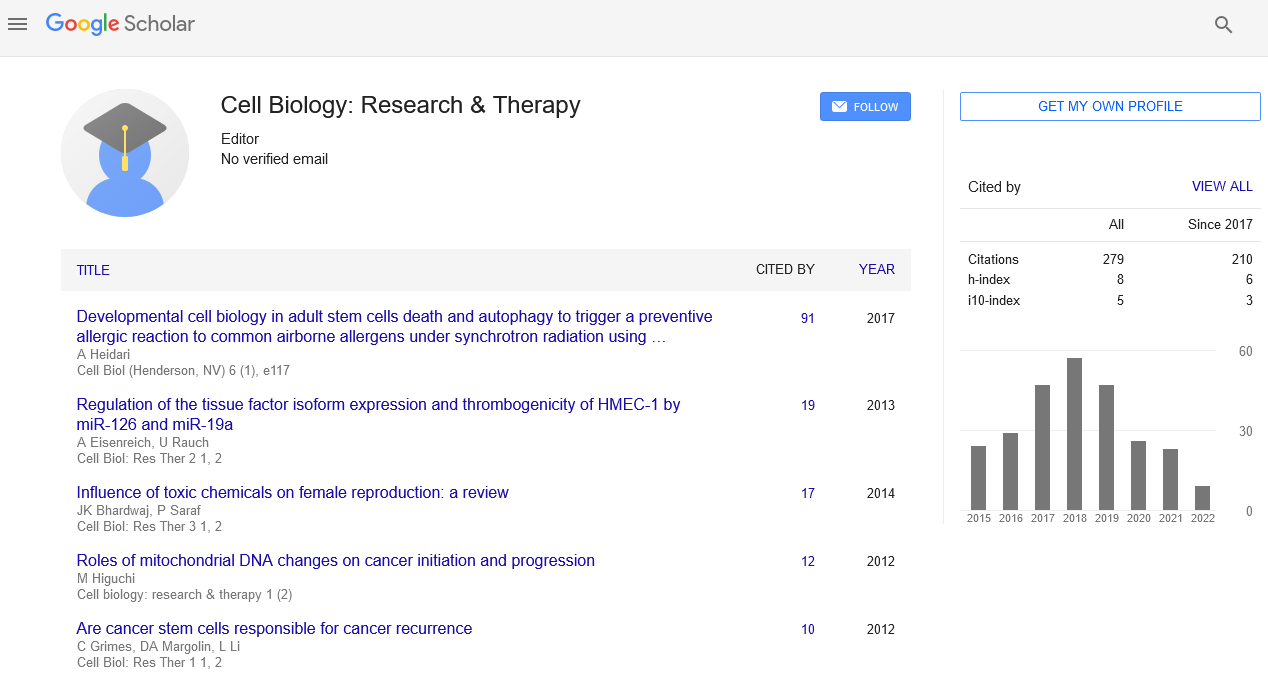Editorial, Cell Biol Res Ther Vol: 2 Issue: 1
HepaRG: An Emerging In vitro Tool
| Muhammad Farooq* |
| Molecular Toxicology Group, Division of Applied Medicine, School of Medicine and Dentistry, University of Aberdeen, Aberdeen, AB25 2ZD, Scotland, UK |
| Corresponding author : Dr. Muhammad Farooq, PhD Molecular Toxicology Group, Division of Applied Medicine, School of Medicine and Dentistry, University of Aberdeen, Aberdeen, AB25 2ZD, Scotland, UK, E-mail: m.farooq@abdn.ac.uk |
| Received: January 19, 2013 Accepted: January 21, 2013 Published: January 24, 2013 |
| Citation: Farooq M (2013) HepaRG: An Emerging In vitro Tool. Cell Biol: Res Ther 2:1 doi:10.4172/2324-9293.1000e112 |
| Safety of new drug candidates is routinely assessed by using in vitro hepatocyte models such as primary human hepatocytes (PHH) and establishedhuman liver cell lines. Although PHH remain the gold standard, their limited and unpredictable availability, inability to proliferate, rapid loss of drug metabolising enzymes and interindividual variability are major disadvantages. To overcome these problems, many human liver cell lines have been developed. These stable cell lines are easy to work with and are available in large quantities but they lack most of the liver-specific functions and present altered gene expression profiles. Despite these issues, some of these cell lines such as nontumorigenic immortalised cell line Fa2N- 4 and hepatoma cell line HepG2 are frequently used in preclinical testing. Recently, a new human liver cell line HepaRG, derived from a female hepatocarcinoma patient has been made available. Bipotent progenitor HepaRG cells differentiate into hepatocytes and biliary epithelial cells and exhibit capability of maintaining liver-specific functions. A genome-wide gene expression profile analysis showed greater similarities between PHH and HepaRG cells as compared to HepG2 cells [1]. Regulation of carbohydrate metabolism, production of albumin and lactate, elimination of sorbitol and galactose at comparable rates to PHH make HepaRG cells the best differentiated cell line available and an in vitro tool of choice [2]. | |
| Thus far, characterisation of HepaRG cells supports their utility in a variety of applications.The high levels of phase I and phase II drug metabolising enzymes, adequate expression and activity levels of uptake and efflux transporters and sufficient expression levels of functional transcription factors make HepaRG cell line a good model for enzyme inhibition, enzyme induction, metabolism and transport studies [3-5]. | |
| New drug candidates are regularly screened for hepatotoxicities such as cholestasis, steatosis and phospholipidosis. HepaRG cells express functional bile acid transporters that are responsive to known cholestatic drugs. This indicates potential usefulness of HepaRG cells as a model to study the mechanisms of cholestasis and a platform to screen for cholestatic potential of new drug candidates. A direct correlation between transcript levels of lipid synthesis markers and lipid accumulation in response to steatogenic drugs in HepaRG cells makes them first in vitro hepatic models to predict drug induced steatosis. Similarly a correlation between lipid synthesis genes and accumulation of phospholipids in response to drugs known to cause phospholipidosis is also reported in HepaRG cells. Furthermore, ability of HepaRG cells to discriminate between steatosis and phospholipidosis in response to single and repeat dose administration respectively makes them an excellent model for phospholipidosis studies [6]. | |
| IC50s of known hepatotoxicants such as acetaminophen and aflatoxin B1 in HepaRG cells are similar to those measured in PHH demonstrating suitability of this cell line as a model for cytotoxicity assays. HepaRG cells are also thought suitable to be used in micronucleus and Comet assays for genotoxicity testing. | |
| Production of interleukins (IL-1-β and IL-6) and up regulation of tumour necrosis factor α (TNF-α) that is mediated by Tolllike receptor-4 (TLR4) and its co-receptor CD14 in response to lipopolysaccharide (LPS) release play central role in inflammatory processes. Both TLR4 and CD14 are not only expressed in HepaRG cells but also they exhibit PHH like responsiveness to inflammatory stimuli indicating usefulness of this cell line for inflammation studies [7]. | |
| Currently available viral infection models are of limited capabilities and there is an urgent need for a better model. HepaRG cells are shown to be the first hepatoma cell line susceptible to hepatitis B virus (HBV) and the associated hepatitis delta virus (HDV). Characterisation of HBV entry and replication mechanism in these cells supports the utility of this cell line to study viral infections [2]. | |
| Despite all these desirable characteristics, there are certain disadvantages attached to the usage of HepaRG cells such as media dependent variability in enzyme and nuclear receptor levels, media dependent response levels to the enzyme inducers andthe cost of cell line. | |
| In conclusion, HepaRG cells presents an impressive profile including functional resemblance with PHH, predictive of clinical responses and exhibit a wide scope of applications. | |
References |
|
|
 Spanish
Spanish  Chinese
Chinese  Russian
Russian  German
German  French
French  Japanese
Japanese  Portuguese
Portuguese  Hindi
Hindi 